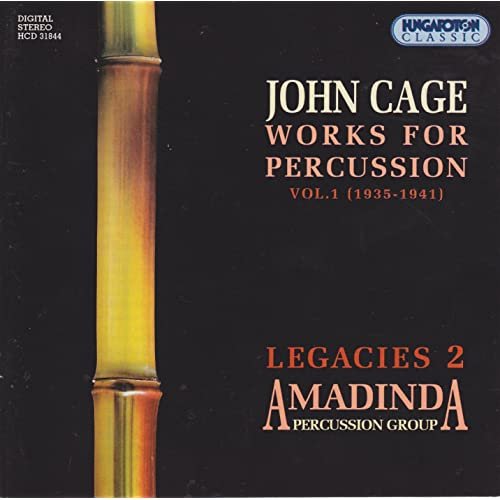
Amadinda Percussion Group - John Cage: Works for Percussion vol.1 (1999)
BAND/ARTIST: Amadinda Percussion Group
- Title: John Cage: Works for Percussion vol.1
- Year Of Release: 1999
- Label: Hungaroton Classic
- Genre: Avant-garde / Modern Classic
- Quality: APE (image+.cue,log,scans)
- Total Time: 68:11
- Total Size: 237 MB
- WebSite: Album Preview
Tracklist:
QUARTET - (Santa Monica, California, 1935) Arranged by Z. Váczi (21´02")
1 I. Moderate (3´32")
2 II. Very slow (6´58")
3 III. Axial Asymmetry. Slow (6´20")
4 IV. Fast (4´12")
TRIO (Santa Monica, 1936) (3´59")
5 I. Allegro (0´54")
6 II. March (1´45")
7 III. Waltz (1´20")
8 IMAGINARY LANDSCAPE No 1 (Seattle, Spring 1939) (7´16")
9 FIRST CONSTRUCTION (IN METAL) (Seattle, Washington, November 1939) (11´36")
10 SECOND CONSTRUCTION (Seattle, January 1940) (8´00")
LIVING ROM MUSIC (San Francisco, 1940) (8´16")
11 I. To Begin (0´46")
12 II. Story (2´13")
13 III. Melody (2´35")
14 IV. End (2´42")
15 J. CAGE-LOU HARRISON: DOUBLE MUSIC (San Francisco, April 1941) (7´00")
QUARTET - (Santa Monica, California, 1935) Arranged by Z. Váczi (21´02")
1 I. Moderate (3´32")
2 II. Very slow (6´58")
3 III. Axial Asymmetry. Slow (6´20")
4 IV. Fast (4´12")
TRIO (Santa Monica, 1936) (3´59")
5 I. Allegro (0´54")
6 II. March (1´45")
7 III. Waltz (1´20")
8 IMAGINARY LANDSCAPE No 1 (Seattle, Spring 1939) (7´16")
9 FIRST CONSTRUCTION (IN METAL) (Seattle, Washington, November 1939) (11´36")
10 SECOND CONSTRUCTION (Seattle, January 1940) (8´00")
LIVING ROM MUSIC (San Francisco, 1940) (8´16")
11 I. To Begin (0´46")
12 II. Story (2´13")
13 III. Melody (2´35")
14 IV. End (2´42")
15 J. CAGE-LOU HARRISON: DOUBLE MUSIC (San Francisco, April 1941) (7´00")
This is the first release in Hungaroton's projected multi-volume collection of the percussion music of John Cage. Though Cage's experiments in sound go back more than 60 years, his ideas about discrete percussive constructions (especially on prepared piano) have only begun to make themselves known--or perhaps have only recently become intelligible, thanks in large measure to the music of his greatest student, Morton Feldman. Quartet (1935), the longest work here, takes several percussion instruments (some of which are unidentifiable but are clearly made of metal) and constructs a mostly rhythmic, very patient four-movement work. No sounds conflict here; there is no chaos. Cage, like Feldman, relies heavily on the spaces between the sounds to help shape the individual notes or chords. Unlike Feldman, though, Cage always provides his music with a distinct forward propulsion. This is true in Trio, which also flirts with Balinese dance rhythms. Imaginary Landscape No. 1 involves percussion, but only as traditional underscoring. Its main tonality (for it's nothing more than a series of ascending tones) is carried by an unidentified--but Theremin-sounding--electronic instrument. Other lines are carried by a prepared piano.
First Construction in Metal and Second Construction employ a wide range of percussive effects such as mallets (padded and unpadded) on interior piano strings, gongs of differing sizes, glass bottles, and steel drums. Double Music is a collaboration between Cage and Lou Harrison, with Harrison's Southwest Asian temperament melding well with Cage's own alien music. The Amadinda Percussion Group seems quite at home with this music (all of it well-rehearsed and polished) and the recorded sound is spacious, if a bit airy. However, this is quite to the advantage of the music, allowing its meditative character to emerge at the appropriate places. In sum, be warned that listening to the whole disc at one sitting is probably not advisable--nor was this music intended to be heard this way. Taken in small doses, the music goes down rather well. [10/15/2000]
--Paul Cook
First Construction in Metal and Second Construction employ a wide range of percussive effects such as mallets (padded and unpadded) on interior piano strings, gongs of differing sizes, glass bottles, and steel drums. Double Music is a collaboration between Cage and Lou Harrison, with Harrison's Southwest Asian temperament melding well with Cage's own alien music. The Amadinda Percussion Group seems quite at home with this music (all of it well-rehearsed and polished) and the recorded sound is spacious, if a bit airy. However, this is quite to the advantage of the music, allowing its meditative character to emerge at the appropriate places. In sum, be warned that listening to the whole disc at one sitting is probably not advisable--nor was this music intended to be heard this way. Taken in small doses, the music goes down rather well. [10/15/2000]
--Paul Cook
Download Link Isra.Cloud
Amadinda Percussion Group - John Cage: Works for Percussion vol.1 (1999)
My blog
Amadinda Percussion Group - John Cage: Works for Percussion vol.1 (1999)
My blog
As a ISRA.CLOUD's PREMIUM member you will have the following benefits:
- Unlimited high speed downloads
- Download directly without waiting time
- Unlimited parallel downloads
- Support for download accelerators
- No advertising
- Resume broken downloads


